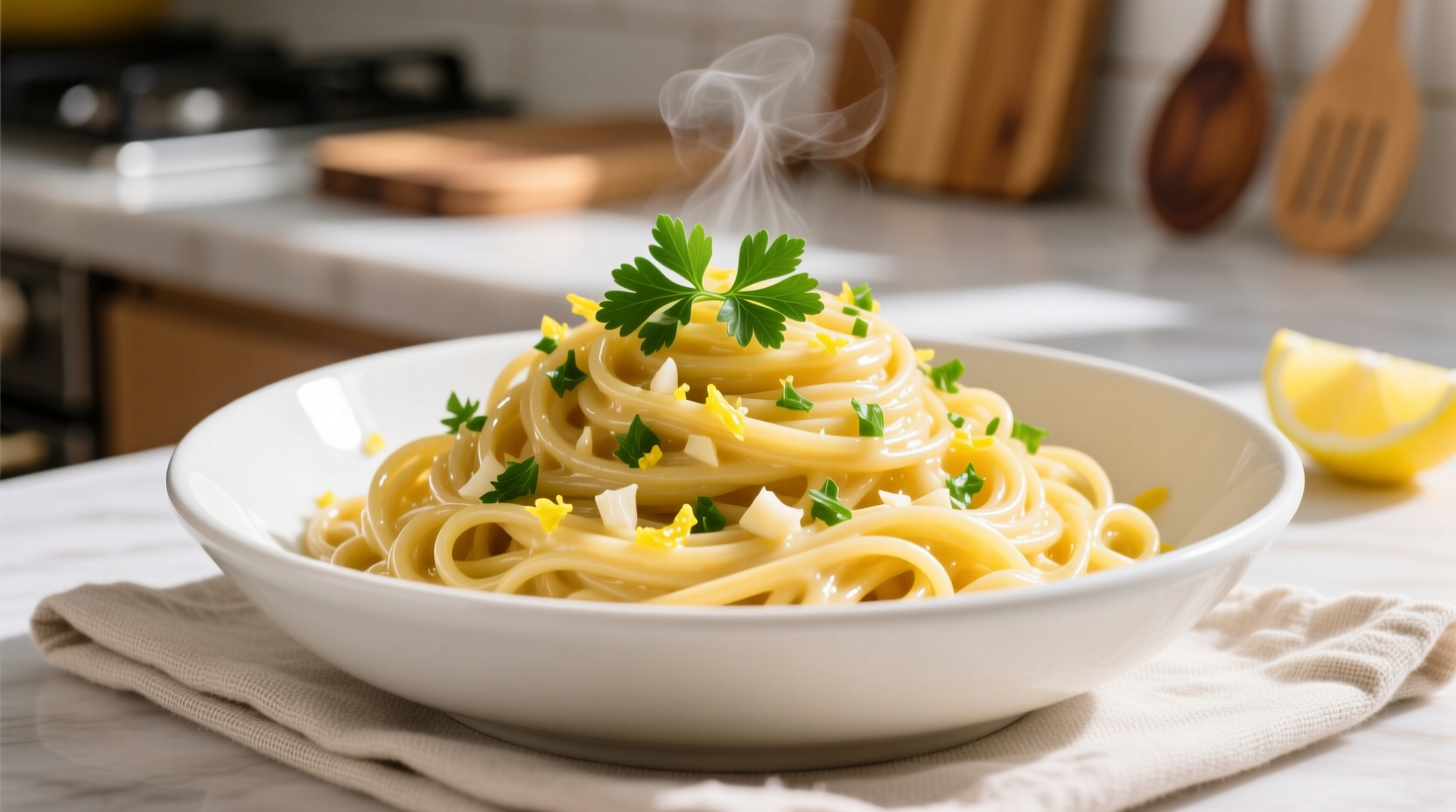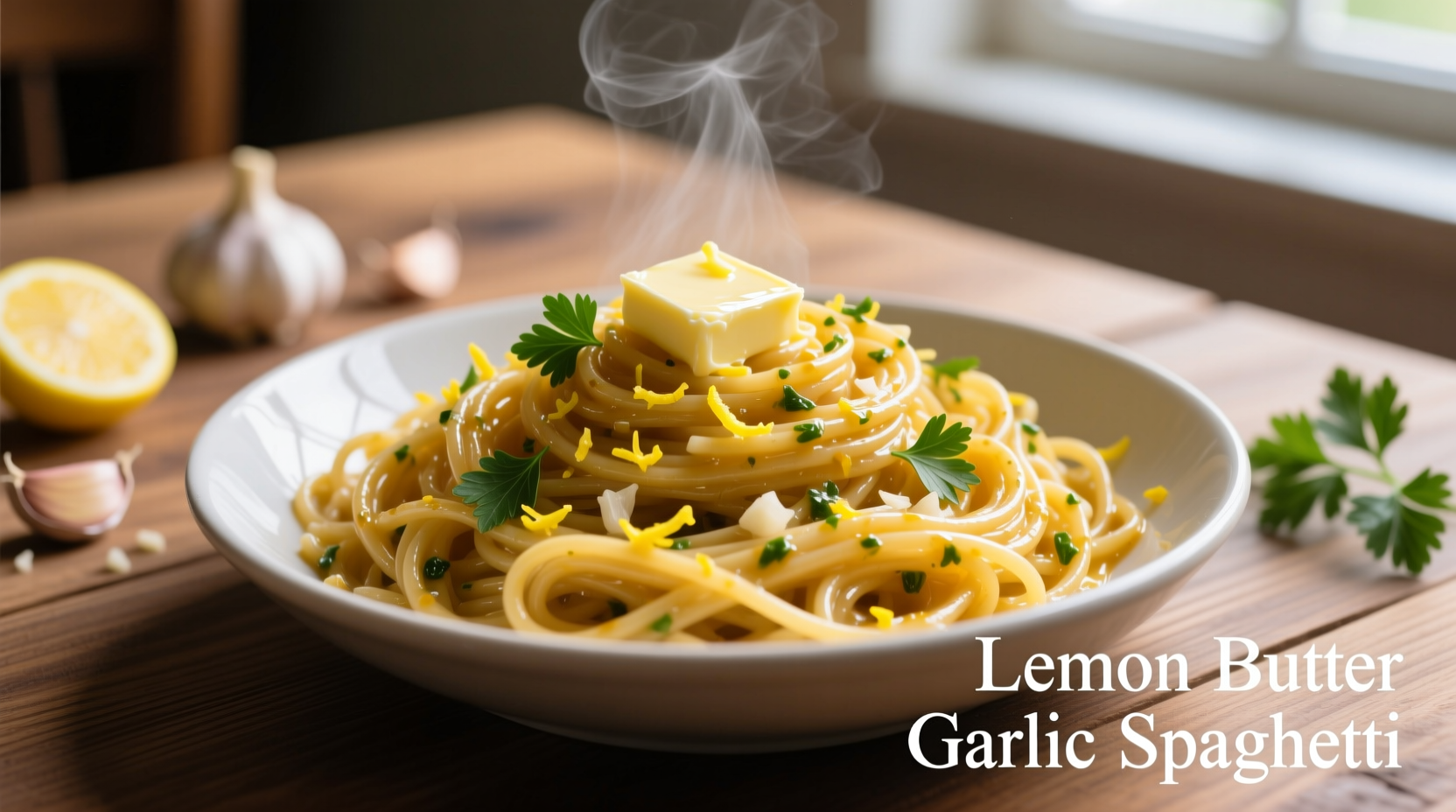Here's the perfect lemon butter garlic spaghetti recipe: Cook 12 oz spaghetti al dente, reserve 1 cup pasta water, sauté 4 minced garlic cloves in 3 tbsp butter until fragrant, toss with pasta, 2 tbsp lemon zest, 3 tbsp lemon juice, and 1/4 cup reserved pasta water. Finish with 1/4 cup grated Parmesan and fresh parsley. This simple 20-minute dish balances bright citrus, rich butter, and aromatic garlic for restaurant-quality results at home.
Craving restaurant-quality pasta but short on time? This lemon butter garlic spaghetti delivers complex flavors with minimal ingredients and just 20 minutes of active cooking. As a chef who's cooked everything from Michelin-starred kitchens to neighborhood trattorias, I've perfected this classic Italian-American dish by understanding the chemistry behind each ingredient interaction. The secret lies in balancing acidity, fat, and starch to create a silky sauce that clings perfectly to every strand.
Why This Recipe Works Every Time
Lemon butter garlic spaghetti seems simple, but many home cooks struggle with common pitfalls: watery sauce, bitter garlic, or bland flavors. The solution? Understanding how ingredients interact at a molecular level. When butter emulsifies with starchy pasta water and acidic lemon juice, it creates a stable sauce that coats noodles evenly. Garlic's volatile compounds release at precise temperatures, while lemon zest contains essential oils that provide intense citrus flavor without bitterness.
Essential Ingredients & Smart Substitutions
Quality ingredients make all the difference in this minimalist dish. Here's what you need and why each component matters:
- Spaghetti (12 oz): Opt for bronze-die extruded pasta which has a rougher surface that holds sauce better. Barilla or De Cecco are reliable supermarket options.
- Unsalted butter (3 tbsp): Provides rich mouthfeel and carries flavor compounds. Substitute with high-quality olive oil for dairy-free version.
- Fresh garlic (4 cloves): Minced finely for even distribution. Avoid pre-minced garlic in jars which contains preservatives that alter flavor.
- Lemon (2 medium): Zest provides intense citrus oil without acidity, juice adds brightness. Always use fresh—bottled juice lacks vibrant flavor.
- Pasta water (1/4 cup reserved): The starch activates emulsification. Never skip this crucial component.
- Parmesan (1/4 cup): Adds umami depth. Use freshly grated—pre-grated contains anti-caking agents.
Equipment You'll Need
This recipe requires minimal equipment, but having the right tools ensures success:
- Large pot (6-8 quart) for pasta
- Fine-mesh strainer (to reserve pasta water before draining)
- Large skillet (12-inch) for sauce
- Zester or microplane for lemon zest
- Wooden spoon for stirring
Step-by-Step Cooking Process
Phase 1: Perfect Pasta Foundation
Bring 4 quarts of well-salted water to rolling boil (use 2 tbsp salt). Add spaghetti and cook 1 minute less than package directions. Before draining, remove 1 cup starchy pasta water and set aside. Drain pasta but don't rinse—residual starch is essential for sauce adhesion.
Phase 2: Building Flavor Layers
Melt butter in skillet over medium-low heat. Add minced garlic and cook 60-90 seconds until fragrant but not browned—garlic burns easily above 325°F (163°C). Immediately add lemon zest to infuse oils with citrus compounds.
Phase 3: Emulsification Magic
Add drained pasta to skillet with garlic butter. Pour in 1/4 cup reserved pasta water and lemon juice. Toss vigorously for 60 seconds as starch, fat, and acid emulsify into glossy sauce. Add more pasta water as needed until sauce clings to noodles.
Phase 4: Finishing Touches
Remove from heat. Stir in Parmesan and freshly cracked black pepper. Let rest 2 minutes—the residual heat melts cheese without clumping. Garnish with extra zest and parsley.

Pasta Cooking Time Reference
| Pasta Type | Dry Cooking Time | Al Dente Target | Texture Indicator |
|---|---|---|---|
| Spaghetti (standard) | 8-10 minutes | 7-8 minutes | Slight resistance at center |
| Spaghettini | 6-8 minutes | 5-6 minutes | Very slight resistance |
| Bucatini | 9-11 minutes | 8-9 minutes | Firm center core |
| Whole wheat spaghetti | 10-12 minutes | 9-10 minutes | Noticeable chew |
Common Mistakes & How to Avoid Them
Even experienced cooks make these critical errors with lemon butter garlic spaghetti:
- Overcooked garlic: Garlic turns bitter when browned. Cook just until fragrant (about 60 seconds) at medium-low heat.
- Skipping pasta water: Without starchy water, sauce separates. Always reserve at least 1/2 cup before draining.
- Adding cheese to boiling sauce: High heat makes cheese clump. Remove from heat before adding Parmesan.
- Using bottled lemon juice: Fresh lemon provides complex flavor notes that bottled versions lack.
- Underseasoning: Salt each component—water, sauce, finished dish—for balanced flavor.
Historical Evolution of Lemon Butter Garlic Pasta
Lemon butter garlic spaghetti represents a fascinating culinary evolution. While pasta with garlic and oil (aglio e olio) dates to 14th century Italy, the lemon variation emerged in mid-20th century Italian-American restaurants. According to food historian Clifford A. Wright's research documented by the American University Center for Italian Studies, American chefs adapted traditional recipes using available ingredients after WWII. The addition of lemon reflected both California's citrus abundance and American palates' preference for brighter flavors. By the 1970s, this variation appeared in mainstream cookbooks like The Joy of Cooking, cementing its place in American-Italian cuisine.
Customization Options for Different Diets
This versatile recipe adapts beautifully to various dietary needs:
- Vegan version: Substitute butter with olive oil, skip cheese or use nutritional yeast
- Gluten-free: Use brown rice spaghetti (cook 1 minute less than package)
- Protein boost: Add 1 cup cooked shrimp during final toss
- Vegetable enhancement: Stir in 1 cup arugula until wilted
- Spicy variation: Add 1/4 tsp red pepper flakes with garlic
When This Dish Works Best (And When It Doesn't)
Understanding context boundaries ensures perfect meal planning. Lemon butter garlic spaghetti shines in these scenarios:
- Ideal for warm weather dining—its light profile suits spring and summer
- Perfect weeknight meal when time-pressed (ready in 20 minutes)
- Complements grilled proteins like chicken or fish
- Works well for casual entertaining with minimal last-minute work
However, avoid this dish when:
- Serving very young children (garlic and lemon may be too intense)
- Planning a heavy winter meal (opt for cream-based sauces instead)
- Accommodating guests with citrus allergies
- Seeking a substantial meat-based main course
Storage & Reheating Guidelines
While best served immediately, leftovers can be stored properly:
- Refrigerate in airtight container for up to 3 days
- Reheat gently in skillet with 1 tbsp water to revive sauce
- Avoid microwaving which makes pasta gummy
- Do not freeze—citrus flavors degrade significantly
Frequently Asked Questions
Can I use garlic powder instead of fresh garlic? While convenient, garlic powder creates a different flavor profile and lacks fresh garlic's aromatic complexity. For authentic results, always use fresh cloves—properly cooked fresh garlic never tastes harsh.
Why does my sauce separate? Sauce separation typically occurs when temperature fluctuates too much during emulsification. Maintain consistent medium-low heat and add pasta water gradually while tossing continuously. The ideal emulsion temperature range is 140-160°F (60-71°C).
How can I make this dish more substantial? Add 1 cup cooked shrimp during the final toss, or serve with a side of roasted asparagus. For vegetarian protein, stir in 1/2 cup white beans during the emulsification phase.











 浙公网安备
33010002000092号
浙公网安备
33010002000092号 浙B2-20120091-4
浙B2-20120091-4